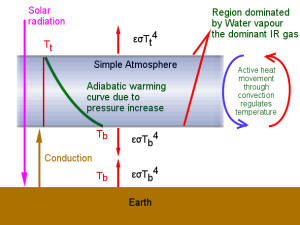
Pressure pushing down causes temperature to rise. So with more gas in the atmosphere the effect would be to increase the global temperature.
There’s a reasonable correlation between atmospheric pressure and the “greenhouse effect” found on various planets and whilst some “Skydragons” might appear to have some crazy ideas, it’s reasonable to accept that rising pressure would cause warming.
Somewhere online I had a really interesting discussion but I’ve now lost it with society distractions, so I will quickly post this as a very plausible addition to the work so far. Now I once said Skydragons were lousy publicists – and to prove it I can’t find any sites on this planetary warming online and the book “Slaying the Sky Dragon” doesn’t obviously have the graph.
So, left is a simple diagram showing how the temperature near the top of the bulk of atmosphere is the one “seen” by space and that below this the temperature rises due to adiabatic heating. (note the gap between atmosphere and earth is not real but instead just the space for me to detail the various flows)
The story is more complex than this because the atmosphere doesn’t have a rigid “top” so greenhouse gases & clouds will alter the effective top. But in principle higher pressure means higher temperatures at the surface.
I must admit that whilst I was aware of this, it never occurred to me that the direct release of volcanic gases might themselves cause global warming by increasing pressure. But it is undoubtedly true that every volcano directly warms the atmosphere by the increase of pressure as a release of gases. I just assumed that effect was so small that it could be ignored (much like thermal expansion of the crust?)
 The Caterpillar theory (i.e. basic physics) requires that the crust will expand when it is heated over an ice-age cycle. This expansion will cause rock to be push outward and with nowhere to go, some will be subducted during heating/expansion and there will be mid-ocean crust formation during cooling-contraction and there’s good evidence this is happening, as ocean crust shows ice-age cycles.
The Caterpillar theory (i.e. basic physics) requires that the crust will expand when it is heated over an ice-age cycle. This expansion will cause rock to be push outward and with nowhere to go, some will be subducted during heating/expansion and there will be mid-ocean crust formation during cooling-contraction and there’s good evidence this is happening, as ocean crust shows ice-age cycles.I have already proposed that this release of gas might in some way be leading to global warming, but I had assumed that the effect would be some form of “greenhouse effect” from radiation trapping perhaps from the potent greenhouse gas Dihydrogen Monoxide (water vapour) – perhaps with some kind of feedback from plants releasing more.
However, after the online discussion, I now realise that the direct release of gas could also have an effect and whilst I would need to do a lot of work to determine how big that effect could be, it does need considering.
If I could find their website I could show the equation, but from memory the 8C temperature change seen over an ice-age cycle requires a change of 20% in atmospheric pressure. That’s quite high – but is it high enough to show up in available records?
Seeing the scale, with Nitrogen being ~80% of the atmosphere I soon realised that it would require the release of nitrogen particularly as the other big gas oxygen must produce noticeable changes that I would doubt could be missed in the fossil record. I hadn’t checked whether nitrogen was evolved from volcanoes, however I quickly found the answer from no less a scientific authority than …. the Daily Mail “The air we breathe was created by volcanoes: Nitrogen escaped from Earth’s crust to create life-giving conditions”
But, despite looking online and even contacting @MetOffice for help I have found no data even on recent atmospheric pressure let alone pressure throughout the ice-age cycle.
So I am now stuck with this hypothesis with no way of checking it:
That the rise in atmospheric temperature was at least in part a result of the release of gases due to thermal expansion & decomposition of the crust.



This is why we should go back to worshipping the volcano gods.
Got a virgin available? 🙂